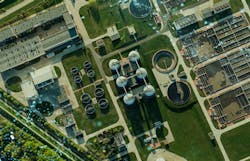We need water. We are so dependent upon it to live, that, when there is a disruption in water distribution it makes people panic in the community. When there is a crisis—like tainted drinking water—it makes the news.
It is hard to imagine that this critical resource is often flowing through an archaic infrastructure of pipes. There are SCADA systems to provide real-time data feeds back to the municipality’s operations center, but visibility is limited to what is happening now. In a real-time world, if there is a water main break, “now” is already too late.
On top of that, there are many stranded assets, like a pump with no sensor that doesn’t send any data back and therefore can’t be monitored remotely.
“We all want to optimize the processes and the network, but you can’t manage what you can’t see,” said Rudy Engert, of Schneider Electric’s business development infrastructure group in North America. “With a stranded asset we have to wait to see what is going on upstream, or until we get a customer complaint.”
Since it’s not likely that cities are going to retrofit thousands of miles of water pipes with sensors on all instrumentation, organizations need to tackle the problem in a different way using operational technology to create predictive models.
Schneider Electric’s Water Network Optimization (WNO) software, services and support solution helps operations managers and control room operators reduce the risk and cost of managing the water distribution network. Included within WNO are the tools that connect Aquis, a simulation engine, with Wonderware System Platform. By including these systems, WNO can provide predictive analytics and what-if scenarios to leverage real time data into future forecasts.
The WNO industry solution layers on top of the technology an organization already has, using information collected from the SCADA system that controls flows, pressures, levels, pumps, etc., and the geographical information system (GIS) for visualizing and mapping what belongs where. In addition, WNO also taps into the engineers’ hydraulic model used for planning network extensions, as well as customer billing systems.
“We take real time measurements from SCADA, asset management from GIS, additional asset data from the hydraulic model, and contacts from the billing system,” said Manuel Parra, business development for Schneider Electric’s Smart Water in the Americas.
Control operators can use WNO to build simulations off of the existing real time models, adding processes and conditions to create scenarios of what could happen if that pump shuts off at 3:00 a.m., for example. And, because the software is looking at the operation, no hydraulic skills are needed.
WNO can show the performance of a network zone—vs. specific data points coming from the SCADA system— and then analyze that behavior, thereby creating a simulation of areas that typically can’t be accessed. Now, rather than waiting for a technician to call back with information from the field, and making a decision without all of the understanding of its impact, operators can click on the interface to see what would happen if they closed a valve.
Because there is a visual of the zones, and WNO has customer contact information, it provides the ability to show the area of the community were people may have a disruption in their water service as a result of that valve closing, to then let operators proactively manage the customer experience in the most positive manner.
“With a couple of clicks you can assess if [your decision] is a viable option,” Engert said. “It is giving context to the data from the whole activity… to let you to do what couldn’t do in the past, because you didn’t have sensors or predictive abilities to do so.”

